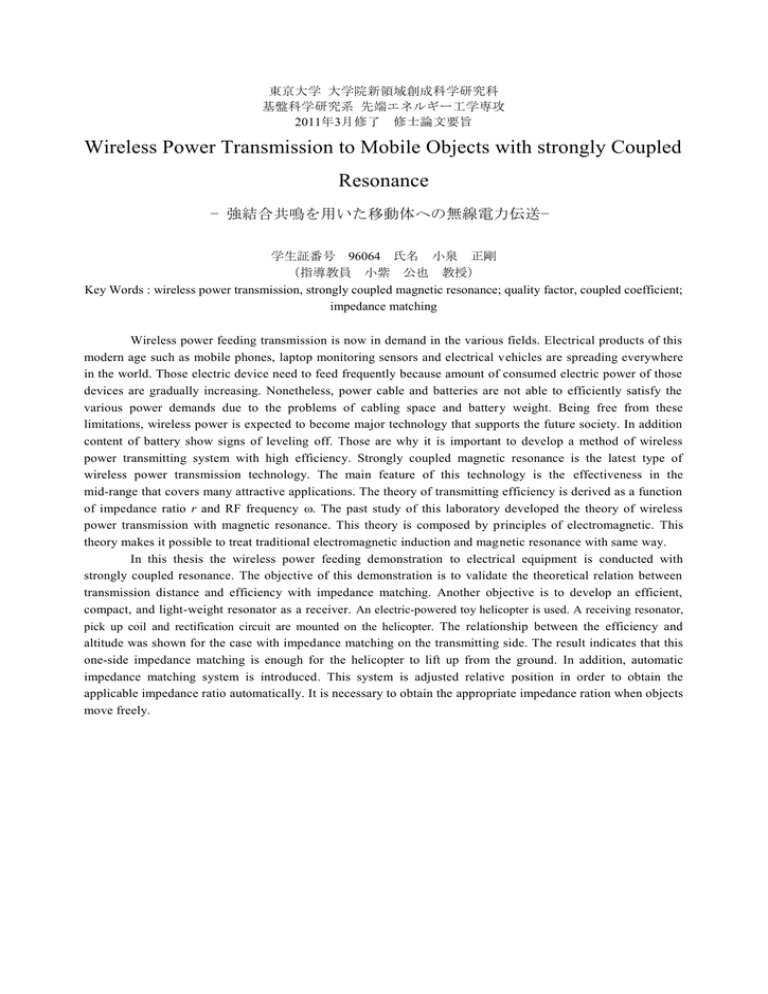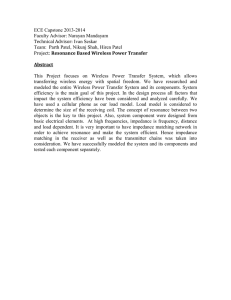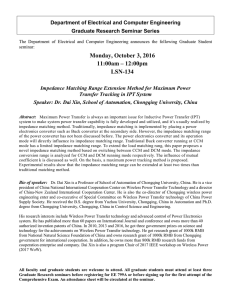Wireless Power Transmission to Mobile Objects with strongly
advertisement

東京大学 大学院新領域創成科学研究科 基盤科学研究系 先端エネルギー工学専攻 2011年3月修了 修士論文要旨 Wireless Power Transmission to Mobile Objects with strongly Coupled Resonance − 強結合共鳴を用いた移動体への無線電力伝送− 学生証番号 96064 氏名 小泉 正剛 (指導教員 小紫 公也 教授) Key Words : wireless power transmission, strongly coupled magnetic resonance; quality factor, coupled coefficient; impedance matching Wireless power feeding transmission is now in demand in the various fields. Electrical products of this modern age such as mobile phones, laptop monitoring sensors and electrical vehicles are spreading everywhere in the world. Those electric device need to feed frequently because amount of consumed electric power of those devices are gradually increasing. Nonetheless, power cable and batteries are not able to efficiently satisfy the various power demands due to the problems of cabling space and battery weight. Being free from these limitations, wireless power is expected to become major technology that supports the future society. In addition content of battery show signs of leveling off. Those are why it is important to develop a method of wireless power transmitting system with high efficiency. Strongly coupled magnetic resonance is the latest type of wireless power transmission technology. The main feature of this technology is the effectiveness in the mid-range that covers many attractive applications. The theory of transmitting efficiency is derived as a function of impedance ratio r and RF frequency . The past study of this laboratory developed the theory of wireless power transmission with magnetic resonance. This theory is composed by principles of electromagnetic. This theory makes it possible to treat traditional electromagnetic induction and magnetic resonance with same way. In this thesis the wireless power feeding demonstration to electrical equipment is conducted with strongly coupled resonance. The objective of this demonstration is to validate the theoretical relation between transmission distance and efficiency with impedance matching. Another objective is to develop an efficient, compact, and light-weight resonator as a receiver. An electric-powered toy helicopter is used. A receiving resonator, pick up coil and rectification circuit are mounted on the helicopter. The relationship between the efficiency and altitude was shown for the case with impedance matching on the transmitting side. The result indicates that this one-side impedance matching is enough for the helicopter to lift up from the ground. In addition, automatic impedance matching system is introduced. This system is adjusted relative position in order to obtain the applicable impedance ratio automatically. It is necessary to obtain the appropriate impedance ration when objects move freely.

